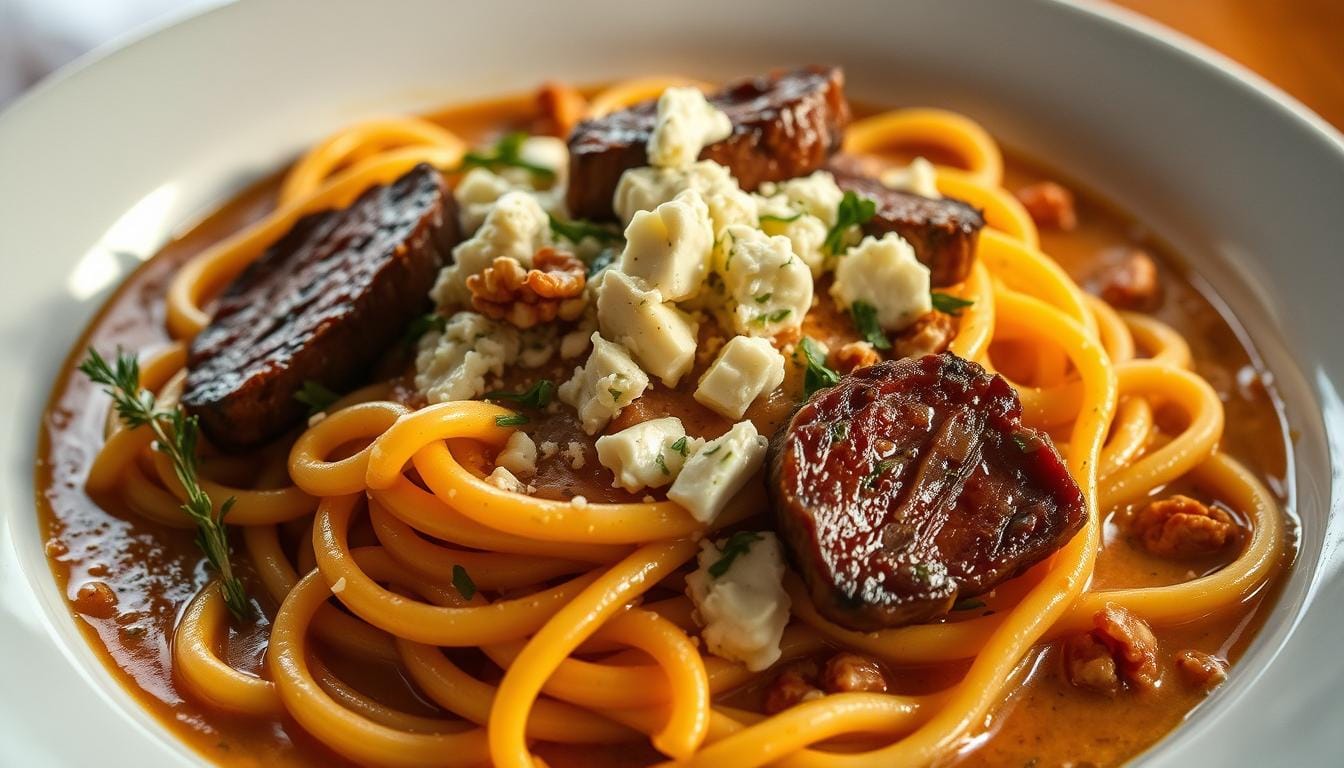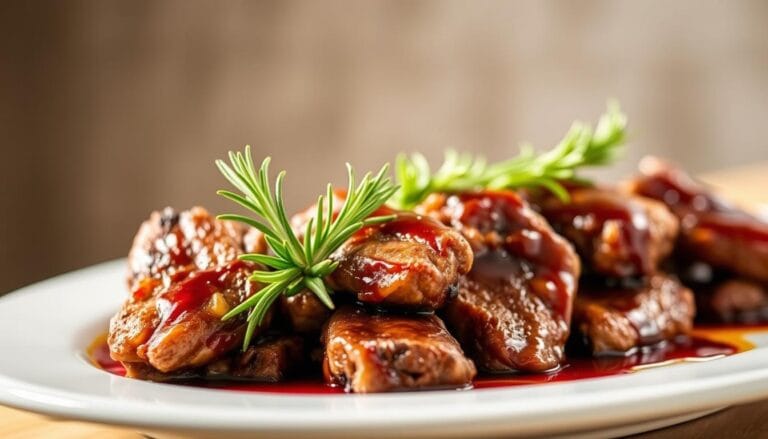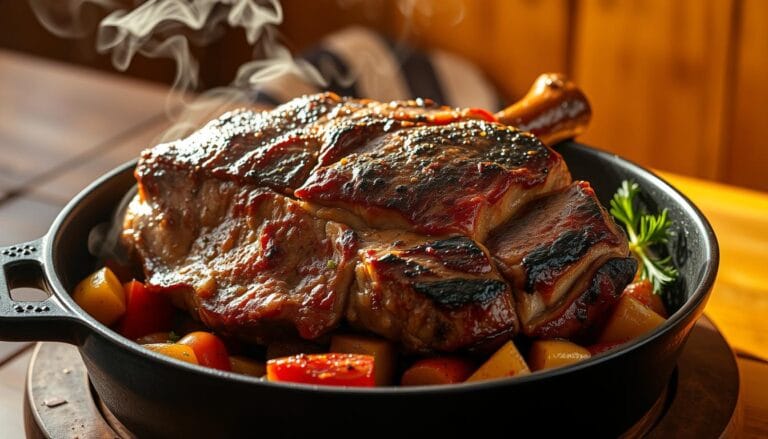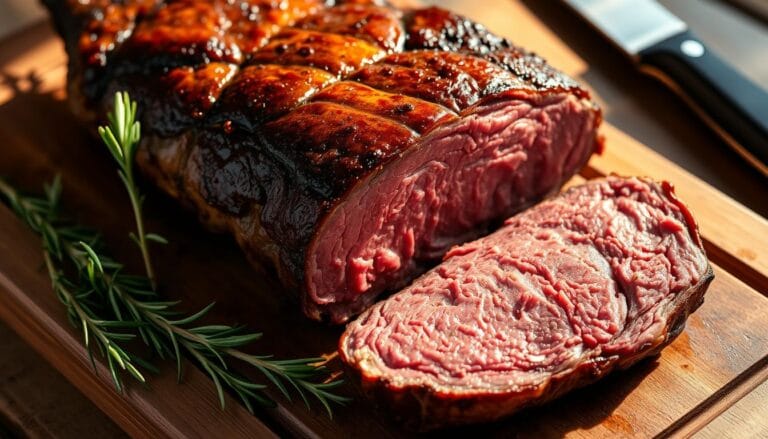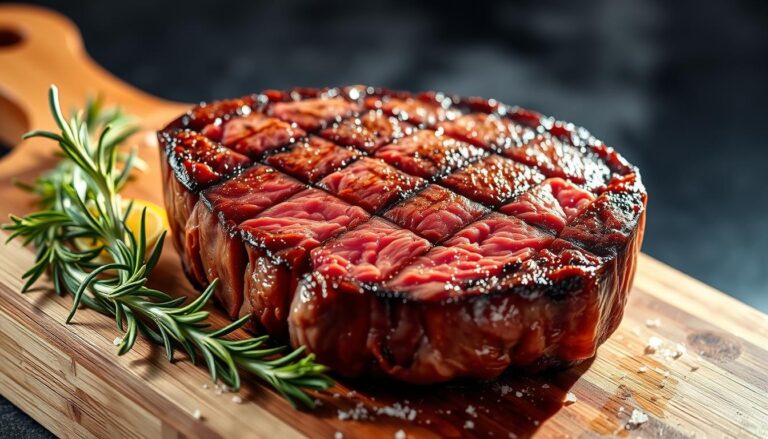Creamy Steak Gorgonzola Pasta Everyone Will Ask You About
Table of Contents
Creamy Steak Gorgonzola Pasta Everyone Will Ask You About
Imagine a meal that feels like a warm hug and makes you feel like a gourmet chef. Picture golden seared beef, silky pasta, and a sauce so rich it turns any night into a celebration. That’s the magic of steak gorgonzola pasta—a dish that makes dinner conversations exciting.
Maybe you’ve had something similar at a fancy restaurant and thought, “I could never make this at home.” This guide is about more than just following steps. It’s about creating moments where everyone wants to stay longer and ask for the recipe.
We’ll show you how to pick the right meat, balance gorgonzola’s flavor, and get that restaurant-quality finish in under 30 minutes. Great food should be joyful, approachable, and worth making again and again.
Key Takeaways
- Whip up restaurant-quality meals in 30 minutes using simple techniques
- Balance bold gorgonzola flavor with creamy sauces that won’t overpower
- Choose affordable beef cuts that stay tender during quick cooking
- Master pan-searing for perfect crusts without drying out the meat
- Customize the dish with seasonal ingredients or dietary preferences
What is Steak Gorgonzola Pasta?
Imagine tender steak slices in a creamy blue cheese sauce, mixed with pasta. This is steak gorgonzola pasta. It’s a dish that combines rich, tangy, and savory tastes. It became famous thanks to Olive Garden’s steak gorgonzola dish, but its roots are in Italy.
Origins of the Dish
The dish comes from Northern Italy, where gorgonzola cheese has been made for centuries. Farmers in Lombardy and Piedmont paired it with meats. This created hearty dishes that celebrated local ingredients. Over time, it evolved into the pasta dish we love today.
Olive Garden made it popular with their version. They used flank steak and a milder sauce for American tastes. But the dish’s Italian heart remains—bold flavors and simple, quality ingredients.
Key Ingredients
Four elements make up this dish:
- Steak: Flank or sirloin is best. These cuts cook fast and stay tender.
- Gorgonzola Dolce: The creamier version of gorgonzola, it melts well in sauces.
- Heavy Cream: It makes the sauce rich and balances the cheese’s sharpness.
- Pasta: Wide noodles like fettuccine or pappardelle are best. Penne is good for a chunkier bite.
Why Choose Steak Gorgonzola Pasta?
This dish is perfect for both casual and fancy meals. It’s creamy and rich, making it great for comfort food nights. But it’s also sophisticated enough for special occasions. The Olive Garden steak pasta is a favorite for its perfect mix of flavors.
Comfort Food Appeal
Steak gorgonzola pasta is incredibly comforting. The sauce is smooth, and the noodles are tender. The steak adds protein, making it a satisfying meal. It’s perfect for busy nights when you want something tasty but quick.
Chef Marcus Wareing said, “Great comfort food isn’t lazy – it’s about creating depth with minimal effort.”
The Olive Garden version is a great example. It uses simple ingredients but adds complex flavors. Let’s see how it compares to making it at home:
| Feature | Weeknight Meal | Special Occasion |
|---|---|---|
| Prep Time | 30 minutes | 45 minutes |
| Presentation | Family-style bowl | Plated with garnish |
| Key Ingredient | Pre-cooked steak strips | Filet mignon medallions |
Perfect for Special Occasions
Make this dish special with a few tweaks:
- Use ribeye steaks instead of sirloin
- Add truffle oil to the sauce
- Serve in individual copper pans
It’s great for holidays or romantic dinners. The gorgonzola and steak make it a hit with candlelight and wine. Many say it’s their favorite for anniversaries, impressing everyone without too much effort.
The Health Benefits of Gorgonzola Cheese
Steak gorgonzola pasta is a treat, but its main ingredient, gorgonzola cheese, is packed with nutrients. It’s a mix of indulgence and health benefits. Let’s dive into how you can enjoy it wisely.
Nutritional Profile
A 1-ounce serving of gorgonzola has 150mg of calcium, which is 15% of what you need daily. It also has 6g of protein. And, it has 8g of saturated fat, which is less than many other blue cheeses.
Here’s how it compares to other cheeses:
| Cheese Type | Saturated Fat (per oz) | Calcium (%DV) | Protein (g) |
|---|---|---|---|
| Gorgonzola | 8g | 15% | 6 |
| Blue Cheese | 10g | 12% | 5 |
| Cheddar | 9g | 20% | 7 |
How It Fits into Your Diet
For those who love steak gorgonzola, it’s important to watch your portions. Here are some tips:
- Use 2oz cheese per 4 servings
- Pair with peppery arugula salads
- Choose whole-grain pasta for fiber
The cheese’s bold taste means you can use less. Balance creamy sauces with something acidic, like balsamic glaze. Your taste buds and stomach will appreciate it.
Essential Ingredients for Your Recipe
Great meals start with great ingredients. For your steak gorgonzola alfredo recipe, three components are key. You need pasta that holds sauce well, steak that’s tender, and cheese that adds bold flavor. Let’s explore how to pick each element like a pro.
Choosing the Right Pasta
Pappardelle is your secret weapon here. Its wide, flat shape holds the creamy gorgonzola sauce better than spaghetti or penne. Unlike traditional alfredo recipes, this dish uses heavy cream for a richer texture. So, you need pasta that won’t let that velvety sauce go to waste.
Runner-up options include fettuccine or tagliatelle, but avoid delicate shapes like angel hair. Pro tip: Salt your pasta water generously. It’s the only chance to season the noodles themselves!
Selecting Quality Steak
Ribeye steals the show with its marbling—those thin streaks of fat that keep the meat juicy during cooking. Look for USDA Choice or Prime grades, and aim for 1-inch thick cuts. Thinner steaks risk overcooking before you get that perfect sear.
If ribeye isn’t available, strip steak or flat iron cuts work too. Just remember: Fat equals flavor. Lean cuts like filet mignon might sound fancy, but they’ll dry out faster than a desert creek.
Gorgonzola Cheese Varieties
Not all gorgonzola is created equal. For this recipe, gorgonzola dolce (the “sweet” variety) is better than its sharper cousin, piccante. Dolce’s creamier texture blends smoothly into sauces, while piccante’s intense tang can dominate other flavors.
| Type | Age | Best For |
|---|---|---|
| Gorgonzola Dolce | 2-3 months | Sauces, dressings |
| Gorgonzola Piccante | 6+ months | Cheese boards, bold dishes |
Can’t find dolce? Mix equal parts mild blue cheese and mascarpone for a similar effect. Avoid pre-crumbled varieties—they’re drier and won’t melt as evenly.
How to Cook the Perfect Steak
Learning how to cook steak can make your steak gorgonzola pasta truly special. Whether you like the smoky taste of the grill or a crispy crust from a cast-iron pan, the right cooking method is key. It ensures your steak is tender and full of flavor every time.
Techniques for Grilling
Grilling gives your steak a smoky flavor that goes well with creamy gorgonzola. First, heat your grill to 450°F. Then, brush the grates with oil to stop the steak from sticking. Cook the steak for 3-4 minutes on each side for a medium-rare. Turn it 90 degrees halfway to get those nice grill marks. Use a meat thermometer to check if it’s 130°F inside.
| Method | Heat Level | Key Benefit |
|---|---|---|
| Grill Marks | High (450°F+) | Smoky flavor & visual appeal |
| Cast-Iron Crust | Medium-High | Even sear & caramelization |
Pan-Seared Options
For cooking indoors, heat a cast-iron skillet until it’s screaming hot. Use a high-smoke-point oil like avocado or grapeseed. Press the steak into the pan to get a crispy crust. Flip it after 4 minutes, then lower the heat to finish cooking.
Importance of Resting Time
It’s essential to let the steak rest for 5 minutes after cooking. This lets the juices spread out, so your steak stays juicy when you slice it. Cover it loosely with foil to keep it warm without making it steamy.
“Resting meat is like letting a good story breathe—it makes the finale worth waiting for.”
Use these cooking methods with your steak gorgonzola pasta recipe. It will create a dish with bold flavors and a tender texture.
Cooking the Pasta to Perfection
The secret to making great steak Gorgonzola pasta is in the pasta itself. While the steak and sauce get all the praise, bad pasta can mess up the dish. Let’s look at how to get the pasta just right and avoid common mistakes.
Al Dente vs. Fully Cooked
Al dente pasta is key for this recipe. It’s slightly firm and holds up well against the creamy Gorgonzola sauce. This prevents the pasta from getting soggy. On the other hand, fully cooked pasta turns mushy and soaks up too much sauce, weakening the flavors.
| Al Dente | Fully Cooked | |
|---|---|---|
| Texture | Firm center | Soft throughout |
| Sauce Adherence | Clings evenly | Slides off |
| Best For | Creamy sauces | Broth-based dishes |
Tips for Preventing Stickiness
Olive Garden’s trick for avoiding sticky pasta doesn’t use oil. Instead, use a big pot and stir every 90 seconds. Here’s why it works:
- Ample water volume reduces starch concentration
- Frequent stirring prevents clumping
- Salt added early enhances flavor absorption
Drain the pasta right after cooking and toss it with a bit of reserved pasta water. This keeps the noodles apart and ready for your Gorgonzola sauce.
Making the Creamy Gorgonzola Sauce
The secret to a rich, velvety Gorgonzola sauce is finding the right balance. Unlike Olive Garden’s heavy cream, this recipe uses a roux base. This gives you better control over thickness and flavor. Whether you’re a home cook or a seasoned chef, mastering this sauce will make your steak gorgonzola alfredo recipe unforgettable.
Key Steps to a Perfect Sauce
Begin by melting butter in a saucepan over medium heat. Then, whisk in flour to make a golden roux. This step prevents the sauce from separating later.
Slowly add whole milk, stirring constantly to avoid lumps. When it thickens, lower the heat. Then, add crumbled Gorgonzola until it melts into a smooth texture. Finish with a pinch of nutmeg and black pepper for extra depth.
Ingredient Substitutions
Don’t have heavy cream? Use mascarpone for extra richness. For a lighter sauce, try half-and-half instead of whole milk. Vegetarians can use vegetable broth instead of beef stock.
If Gorgonzola’s bold flavor is too much, blend it with milder cheeses. Try fontina or mozzarella for a milder taste.
Assembling Your Dish
The final step in making steak gorgonzola pasta is where creativity meets taste. It’s all about putting everything together right. This way, every bite is full of creamy cheese, savory steak, and just the right mix of textures. Follow these steps to make your dish a true masterpiece.
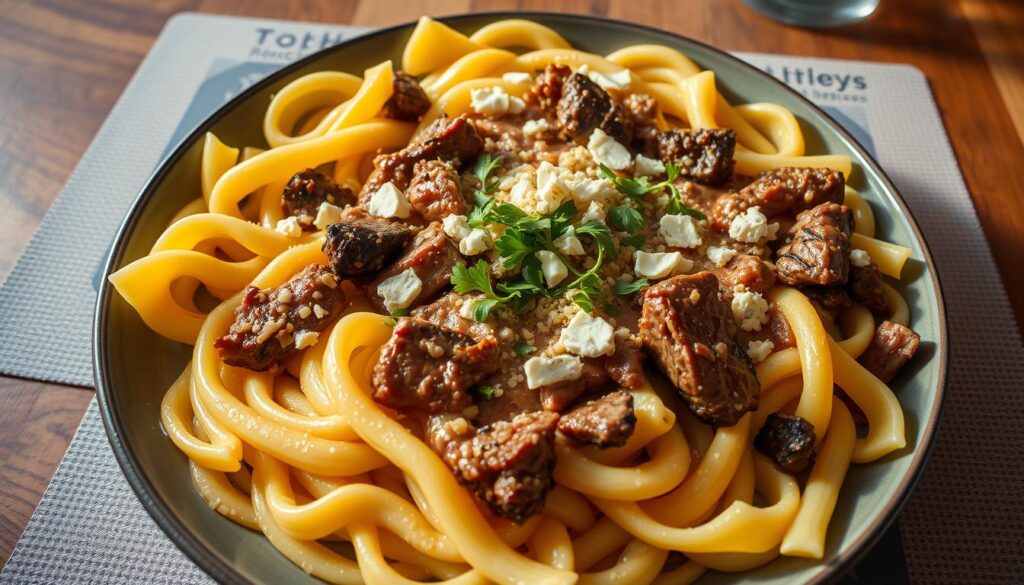
Layering Techniques
Always coat pasta in sauce first to set the flavor base. Toss cooked noodles in warm gorgonzola cream until they’re well coated. This keeps the pasta moist and lets the steak stand out on top.
Cut your rested steak into thin strips against the grain. Place them diagonally over the pasta for a nice look. Don’t mix the meat with the noodles. This keeps the steak juicy and its charred flavor intact.
Garnishing Tips
Use contrasting elements to balance the dish’s richness:
- Toasted pine nuts – adds crunch
- Chive oil drizzle – introduces freshness
- Microgreens – provides color contrast
Finish with a light dusting of aged gorgonzola crumbles. This adds to the cheese flavor without overpowering. Serve it right away when the sauce is smooth and creamy.
Pairing Wine with Steak Gorgonzola Pasta
A rich dish like steak Gorgonzola pasta needs a wine that complements its bold flavors. The creamy sauce and savory steak require drinks that balance their intensity. Let’s explore how to elevate your meal with smart pairings.
Recommended Wine Varietals
Chianti is a classic choice, perfect if you love Olive Garden’s approach. Its bright acidity cuts through the dish’s richness. For a buttery twist, try an oaked Chardonnay – its vanilla notes harmonize with the cheese’s sharpness.
Prefer reds? A Barbera offers juicy red fruit flavors that contrast the Gorgonzola’s saltiness. Its medium body won’t clash with the pasta’s texture, making it a crowd-pleaser.
Tips for Pairing
Follow these guidelines to nail your wine selection:
- Match acidity levels: High-acid wines (like Chianti) cleanse the palate between bites.
- Consider weight: Heavy sauces pair best with full-bodied wines, while lighter options work with delicate dishes.
- Balance sweetness: Avoid overly sweet wines – they’ll compete with the cheese’s tang.
Remember, personal preference matters most. Taste-test different combinations to find your perfect match!
Serving Suggestions
Make your Steak Gorgonzola Pasta special with the right pairings. These suggestions will enhance its bold flavors. Whether you want something like Olive Garden or lighter options, these ideas will make every bite memorable.
Ideal Side Dishes
Garlic breadsticks are a favorite, just like the Olive Garden steak pasta. Their crispy outside and buttery garlic inside complement the creamy pasta well. For a different take:
| Side Dish | Prep Time | Flavor Notes |
|---|---|---|
| Lemon-Roasted Broccolini | 15 mins | Bright acidity, subtle crunch |
| Marinated Artichokes | 5 mins | Tangy contrast, Mediterranean flair |
| Parmesan Polenta | 20 mins | Creamy texture, savory depth |
Salad Pairings
A lemon kale salad is a great match for the Olive Garden steak pasta. It adds freshness and nutrition. For more protein, try our easy ground beef recipes. Lighter choices include:
- Arugula with pear and candied walnuts
- Shaved fennel and orange segments
- Spinach-strawberry balsamic toss
Remember, keep sides small. This way, the pasta stays the main attraction.
Vegetarian Alternatives
Craving steak gorgonzola pasta but want a plant-based twist? You don’t need meat to enjoy this rich, creamy dish. With smart ingredient swaps, vegetarians and vegans can savor the same bold flavors while keeping the recipe satisfying.
Replacing Steak with Vegetables
Portobello mushrooms are a top choice for mimicking steak’s texture. Their meaty thickness holds up well to grilling or pan-searing. Marinate them in balsamic vinegar and garlic for deeper flavor.
Smoked tofu offers a savory, protein-rich alternative. Slice it thinly and crisp it in a skillet to add a smoky edge. Eggplant or cauliflower steaks also work beautifully when roasted with olive oil and herbs.
Vegan Gorgonzola Cheese Options
Store-bought vegan blue cheeses like Daiya Crumbles provide tanginess similar to traditional gorgonzola. For a homemade option, blend soaked cashews with lemon juice, nutritional yeast, and white miso paste.
- Daiya Crumbles: Ready to use, with a sharp flavor that melts smoothly.
- Cashew-based cheese: Creamier texture and customizable saltiness.
Pair these alternatives with whole-grain pasta or zucchini noodles for a lighter, plant-forward meal.
Storing and Reheating Leftovers
Keep your steak gorgonzola pasta tasting great even after it’s cooled down. With the right techniques, you can preserve its creamy texture and bold flavors for days. Let’s dive into how to store and reheat this dish like a pro.
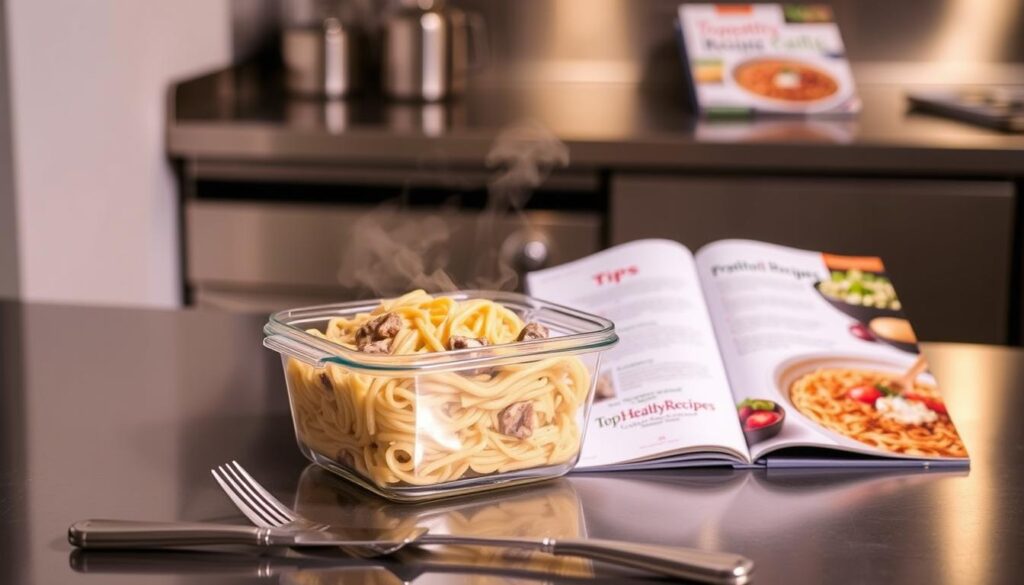
Best Storage Practices
Proper storage is key to maintaining quality. Always transfer leftovers to an airtight container within two hours of cooking. This prevents bacterial growth and keeps the pasta from drying out.
Refrigerate your steak gorgonzola pasta for up to 3-4 days. Avoid freezing if possible – the sauce tends to separate when thawed, creating a grainy texture. If you must freeze, stir vigorously after reheating to help recombine ingredients.
Reheating Tips for Optimal Flavor
Skip the microwave for best results. Instead, use a skillet on low heat with a splash of milk or cream. The dairy helps revive the sauce’s velvety consistency without overpowering the gorgonzola’s tang.
- Heat gradually to prevent scorching
- Stir constantly for even warming
- Add fresh herbs before serving
If you’re short on time, microwave in 30-second intervals. Stir between each burst and add a teaspoon of water to maintain moisture. The steak might lose some tenderness, but the dish will satisfy cravings.
Potential Variations of the Recipe
Want to make steak Gorgonzola pasta your own? It’s easy to add your own twist. You can add more veggies or try new cheeses. Let’s explore some tasty ways to change up your dish, inspired by Olive Garden’s seasonal specials.
Adding Vegetables
Adding veggies can make your dish more flavorful and healthy. Spinach or arugula add a fresh touch. Mushrooms add a rich, earthy flavor.
For a unique taste, try sun-dried tomatoes or caramelized onions. These are favorites in Olive Garden steak Gorgonzola dishes during fall.
Different Cheese Options
While Gorgonzola is key, other cheeses can also be great:
- Cambozola: Creamier and milder than traditional Gorgonzola
- Roquefort: Intense and salty for adventurous palates
- Parmesan: Adds nutty notes when sprinkled on top
| Cheese Type | Flavor Profile | Best For |
|---|---|---|
| Gorgonzola Dolce | Sweet & Mild | First-time cheese explorers |
| Roquefort | Sharp & Salty | Bold flavor lovers |
| Goat Cheese | Tangy & Creamy | Lighter sauce options |
Choose your favorite pasta and steak. Remember, changing cheeses might affect sauce thickness. If using drier cheeses like aged Parmesan, add milk slowly.
Common Mistakes to Avoid
Getting your steak gorgonzola alfredo recipe right takes skill. Even tiny mistakes can mess up the taste and texture. Let’s look at two big mistakes and how to avoid them for top-notch results.
Overcooking the Steak
Patience pays off when cooking steak. Cutting into meat too soon lets juices spill out. Let steaks rest 5-7 minutes under loose foil before slicing.
Use a meat thermometer for exactness. Medium-rare (130-135°F) is best with creamy sauces. Overcooked steak gets tough and can’t match the rich gorgonzola flavors.
Mismanaging the Sauce Consistency
High heat ruins alfredo sauce, making it grainy. Keep the heat low when melting gorgonzola. Stir constantly and add cream slowly to keep it smooth.
If your sauce breaks, try this fix:
- Remove from heat immediately
- Whisk in 1 tsp cornstarch mixed with cold water
- Return to low heat while stirring
Prevent clumps by grating cheese instead of cubing it. Freshly grated parmesan blends better with gorgonzola.
Your Ultimate Steak Gorgonzola Pasta Recipe
Want to make a meal like a restaurant at home? This steak gorgonzola alfredo recipe mixes tender beef, strong cheese, and creamy sauce. It’s inspired by Olive Garden steak pasta and is easy to make. It’s perfect for impressing your guests without needing to be a pro.
Step-by-Step Instructions
- Prep ingredients: Cut 1 lb flank steak into thin strips. Grate 8 oz Gorgonzola cheese. Boil 12 oz fettuccine in salted water until al dente, saving 1 cup pasta water.
- Cook steak: Heat 2 tbsp olive oil in a skillet. Cook steak over medium-high heat for 3-4 minutes on each side. Then, let it rest.
- Make sauce: In the same pan, melt 4 tbsp butter. Add 1 cup heavy cream and Gorgonzola, stirring until smooth. Pro tip: Use reserved pasta water to thin sauce if needed.
- Combine: Toss cooked pasta in sauce. Add steak slices and fresh parsley on top.
Cooking Time and Yield
| Prep Time | Cook Time | Total Time | Yield |
|---|---|---|---|
| 15 minutes | 25 minutes | 40 minutes | 4-6 servings |
This recipe is easy to make for more people – just double the ingredients for 8-10 servings. Leftovers can be stored in airtight containers for up to 3 days. But, it tastes best when it’s freshly made.
Conclusion: Enjoying Your Culinary Creations
Now that you’ve mastered steak gorgonzola pasta, it’s time to enjoy it. This dish turns simple meals into special moments. It combines rich flavors with easy techniques.
Whether you’re cooking for a small dinner or a big party, your skills will impress. Every bite will show off your talent.
Sharing With Friends and Family
Host a pasta night to show off your steak gorgonzola pasta. Serve it with crusty bread, roasted veggies, or a fresh arugula salad. Let guests add extra cheese or balsamic glaze to their plates.
This interactive way of eating encourages conversation. It lets everyone enjoy their meal at their own speed.
Encouraging Feedback and Tips
Share your dishes on social media with #SteakGorgonzolaPasta. Ask friends for their honest thoughts on your sauce and steak. Did you try a different cheese? Share your changes to inspire others.
Cooking is a journey, and every small change makes a big difference. Keep trying new things with flavors, textures, and how you present your dishes. Bookmark this guide for future meals.
Your steak gorgonzola pasta is more than a recipe. It’s a way to grow your kitchen skills and make memories to share.
FAQ
What makes Steak Gorgonzola Pasta different from regular Alfredo pasta?
Can I recreate Olive Garden’s Steak Gorgonzola at home?
What’s the best pasta shape for Steak Gorgonzola Pasta?
How do I prevent the gorgonzola sauce from separating?
Can I use a different cheese if I don’t have gorgonzola?
What wine pairs well with Steak Gorgonzola Pasta?
How do I cook the steak to medium-rare perfection?
Are there vegetarian alternatives for this dish?
Can I freeze leftovers of Steak Gorgonzola Pasta?
What sides pair well with this dish?
Why is my gorgonzola sauce too bitter?
How do I prevent the pasta from sticking together?
For more cooking tips, stay connected with us. We also recommend the cookbook Skinnytaste Simple: Easy, Healthy Recipes with 7 Ingredients or Fewer
For more Recipes about Steak ?
Did You try our recipe ?
There are no reviews yet. Be the first one to write one.
